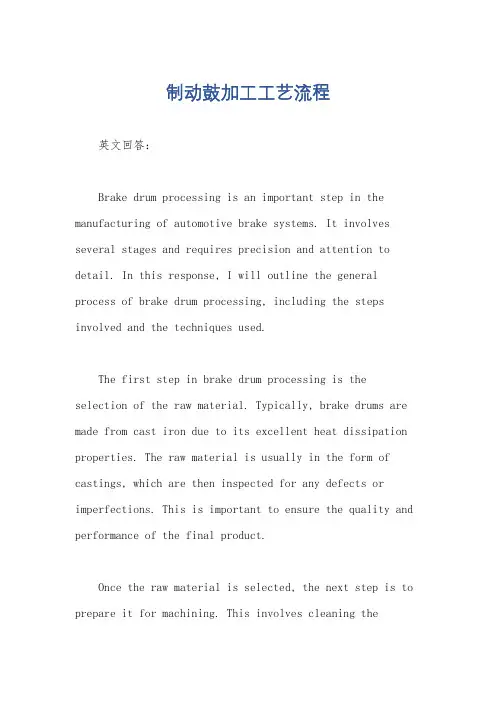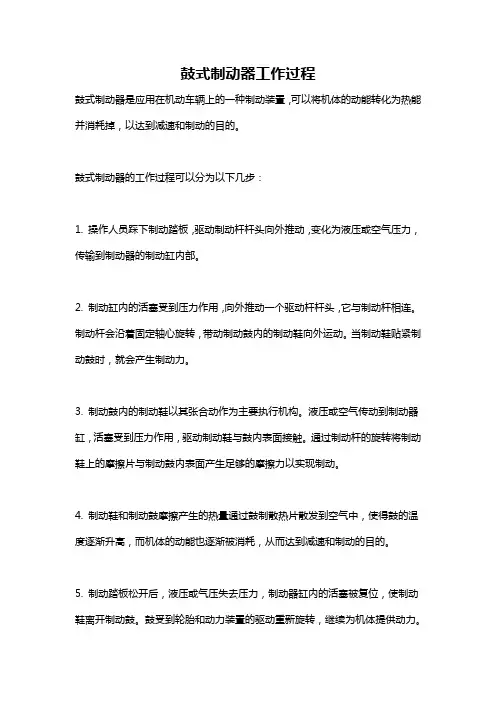制动鼓工艺流程 PPT课件
- 格式:ppt
- 大小:5.49 MB
- 文档页数:38

制动鼓加工工艺流程英文回答:Brake drum processing is an important step in the manufacturing of automotive brake systems. It involves several stages and requires precision and attention to detail. In this response, I will outline the general process of brake drum processing, including the steps involved and the techniques used.The first step in brake drum processing is the selection of the raw material. Typically, brake drums are made from cast iron due to its excellent heat dissipation properties. The raw material is usually in the form of castings, which are then inspected for any defects or imperfections. This is important to ensure the quality and performance of the final product.Once the raw material is selected, the next step is to prepare it for machining. This involves cleaning thecasting to remove any impurities or contaminants. It is also important to ensure that the casting is properly aligned and secured in the machine to prevent any errors during the machining process.The actual machining of the brake drum involves several operations. The first operation is turning, where the outer surface of the drum is machined to achieve the desired dimensions and finish. This is typically done using a lathe machine. The turning process removes any excess material and creates a smooth surface.After turning, the next step is drilling. This involves creating holes in the brake drum for the attachment of the brake shoes or pads. The size and number of holes depend on the specific design requirements of the brake system. The holes are carefully drilled to ensure proper alignment and fit.Once the drilling is complete, the brake drum undergoes a process called grinding. Grinding is used to further refine the surface finish and ensure dimensional accuracy.It involves using abrasive wheels or belts to remove any remaining material and achieve the desired surface texture.The final step in brake drum processing is the inspection and quality control. The finished drum is thoroughly inspected for any defects or imperfections. This includes checking for dimensional accuracy, surface finish, and overall quality. Any issues are addressed and corrected before the brake drum is deemed ready for installation.中文回答:制动鼓加工是汽车制动系统制造过程中的重要环节,涉及多个阶段,需要精确和细致的处理。



鼓式制动器工作过程
鼓式制动器是应用在机动车辆上的一种制动装置,可以将机体的动能转化为热能并消耗掉,以达到减速和制动的目的。
鼓式制动器的工作过程可以分为以下几步:
1. 操作人员踩下制动踏板,驱动制动杆杆头向外推动,变化为液压或空气压力,传输到制动器的制动缸内部。
2. 制动缸内的活塞受到压力作用,向外推动一个驱动杆杆头,它与制动杆相连。
制动杆会沿着固定轴心旋转,带动制动鼓内的制动鞋向外运动。
当制动鞋贴紧制动鼓时,就会产生制动力。
3. 制动鼓内的制动鞋以其张合动作为主要执行机构。
液压或空气传动到制动器缸,活塞受到压力作用,驱动制动鞋与鼓内表面接触。
通过制动杆的旋转将制动鞋上的摩擦片与制动鼓内表面产生足够的摩擦力以实现制动。
4. 制动鞋和制动鼓摩擦产生的热量通过鼓制散热片散发到空气中,使得鼓的温度逐渐升高,而机体的动能也逐渐被消耗,从而达到减速和制动的目的。
5. 制动踏板松开后,液压或气压失去压力,制动器缸内的活塞被复位,使制动鞋离开制动鼓。
鼓受到轮胎和动力装置的驱动重新旋转,继续为机体提供动力。
以上就是鼓式制动器的基本工作过程。
其中最关键的是制动鞋和制动鼓之间的摩擦力,它的大小取决于制动器的结构设计和制动力的大小。
为了确保安全可靠的驾驶,机动车辆的制动装置需要经常保养和检查,并按照规定周期更换制动鞋、制动鼓和制动液等部件。


刹车鼓工艺大全制动鼓是保安件,它涉及到人的生命财产安全,同时它又是易损易耗件。
市场需求量特别大。
目前国内的年产量大约在千万只以上。
因产品结构相对简单,机器造型、手工造型都容易上马,几乎全国各地都有铸造厂在生产制动鼓。
我去过的几家大型企业,机械化流水线生产制动鼓,年产量都在一百万只左右。
笔者也去过一些小企业年产量几万只。
也有像河北隆尧县某镇的一个工业园区,就密集着一百来家铸造厂,都在生产汽车制动鼓;其整个区的制动鼓产量也应在百万只以上。
只不过大型企业生产的制动鼓,一般都是供给国内的车桥厂或是出口国外,而小型企业生产的制动鼓大部分供给零件及售后配件市场。
其产品质量和信誉度难以被正规车桥厂所接受,根据我看到和了解到的这些企业,由于产品结构不同,供货对象不同,因而生产工艺各异,但从总体来讲,质量问题还是有很多,达不到车用制动鼓的质量要求,因此我想有必要和大家在一起对制动鼓的生产工艺进行讨论和研究,互相交流经验,下面就根据笔者的经历和了解的情况,借这次机会和大家交换意见,不对的地方请大家指正。
载重汽车制动鼓的质量要求由于灰铸铁具有良好的导热性、减震性、耐磨性以及优良的铸造性能和低的制造成本,因此机动车辆的制动鼓几乎都采用灰铸铁件,其牌号为HT200和HT250。
我国只有一个灰铸铁件标准——JB/T9439-2010,并没有专用的汽车制动鼓用灰铸铁件标准。
在机标内也没有特殊灰铸铁的说明。
全世界只有美国材料试验学会ASTMA159-1983(1993年重审)专门制订有汽车专用灰铸铁件标准。
对制动鼓依其载重量列有3个铸铁牌号。
同时美国汽车工程师学会SAEJ431的动力机械灰铸铁标准内对制动鼓的质量要求,基本上和ASTMA159-83一致。
目前我国和国外大都参照美国制动鼓标准。
在图样上或验收标准上给出了自己的厂标,一个标准的高低,反映了其工艺水平和质量水平,高水平的标准才能生产出高质量的产品。
下面简要的将上述美国标准和国外的一些好的公司对制动鼓的质量要求,介绍如下供大家参考1.机械性能牌号抗拉强度(MPa) 硬度(HB)G2500a 175 170-229G3500b 245 207-255G3500c 245 207-2552.化学成分牌号总C Si Mn P s 其他合金元素G2500a ≥3.40 1.60-2.10 0.60-0.90 ≤0.15≤0.12按要求G3500b ≥3.40 1.30-1.80 0.60-0.90 ≤0.15≤0.12G3500c ≥3.50 1.30-1.80 0.60-0.90 ≤0.15≤0.12注:1、总C是强制性的要求,必须保证。
